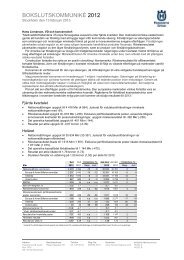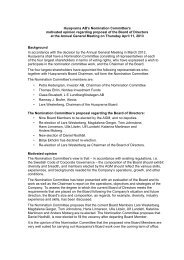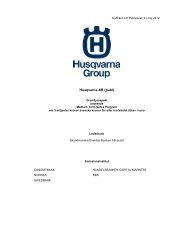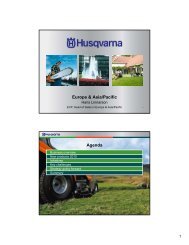Annual Report 2009 - Husqvarna Group
Annual Report 2009 - Husqvarna Group
Annual Report 2009 - Husqvarna Group
You also want an ePaper? Increase the reach of your titles
YUMPU automatically turns print PDFs into web optimized ePapers that Google loves.
Notes <strong>Husqvarna</strong> <strong>Annual</strong> <strong>Report</strong> <strong>2009</strong> 63<br />
Amounts in SEKm unless otherwise stated.<br />
Credit risk<br />
Credit risk in trade receivables<br />
<strong>Husqvarna</strong> sells to a substantial number of customers including<br />
large retailers, buying groups, independent stores and<br />
professional users. Sales are made on the basis of normal<br />
delivery and payment terms. Customer financing solutions are<br />
also normally arranged by third parties. The Credit Policy of<br />
the <strong>Group</strong> ensures that the management process for customer<br />
credits includes customer rating, credit limits, decision<br />
levels and management of bad debts. The Board of Directors<br />
decides on customer credit limits exceeding SEK 100m.<br />
<strong>Husqvarna</strong> uses an internal classification of the creditworthiness<br />
of its customers. The classification has different<br />
levels, from low risk to high risk. In the table below, trade<br />
receivables have been divided into three different intervals.<br />
Credit portfolio<br />
<strong>2009</strong> 2008<br />
Total 3,385 4,184<br />
Low to Moderate Risk 1,847 2,294<br />
Medium Risk to Elevated 1,281 1,491<br />
High Risk 257 402<br />
As of 31 December <strong>2009</strong>, net trade receivables, after provisions<br />
for doubtful accounts, amounted to SEK 3,385m (4,184),<br />
which consequently equals the maximum exposure to losses<br />
in trade receivables. Hence, the book value equals the fair<br />
market value of the receivables. The size of the credit portfolio<br />
is, however, directly dependent upon the seasonal pattern<br />
of <strong>Husqvarna</strong>’s sales. This means that credit expos ure is significantly<br />
higher during the first six to nine months of each calendar<br />
year. A provision for impairment of trade receivables is<br />
established when there is objective evidence that <strong>Husqvarna</strong><br />
will not be able to collect all amounts due according to the<br />
ori gin al terms of the receivables. The amount of the provision<br />
is the difference between the asset’s carrying amount and the<br />
present value of estimated future cash flows, discounted at<br />
the effective interest rate. Provisions for doubtful trade<br />
receivables at the end of the financial year amounted to<br />
SEK 183m (137), of which SEK 182m refer to invoices due.<br />
Overdue trade receivables<br />
Trade receivables that were due but not yet written down<br />
amounted to SEK 569m (782) as of 31 December <strong>2009</strong>.<br />
Ageing analyses for overdue trade receivables<br />
Due but not written down<br />
<strong>2009</strong> 2008<br />
Due for<br />
payment<br />
Due for<br />
payment<br />
Up to 1 month 207 311<br />
1 to 3 months 121 271<br />
>3 months 241 200<br />
569 782<br />
The situation regarding overdue receivables has not changed<br />
significantly since previous year-end taking the total volume<br />
of outstanding trade receivables into account. The fair value<br />
of collateral held for trade receivables due for payment was<br />
SEK 74m (66).<br />
A plan for repayment is normally first designed for customers<br />
with overdue receivables at the same time as the account<br />
is placed under special surveillance. At a later stage, unpaid<br />
products may be repossessed or other securities be enforced.<br />
Concentration of credit risk in trade receivables<br />
Concentration<br />
of credit risk<br />
As of 31 Dec <strong>2009</strong> As of 31 Dec 2008<br />
Number of<br />
customers<br />
Percent<br />
of total<br />
portfolio<br />
Number of<br />
customers<br />
Percent<br />
of total<br />
portfolio<br />
Exposure SEK<br />
100m 2 13% 2 13%<br />
<strong>Husqvarna</strong> has substantial exposure towards a limited number<br />
of large customers, primarily in the US.<br />
Credit risk in financial activities<br />
Exposure to credit risk arises from the investment of liquid<br />
funds and through counterparty risks related to derivatives. In<br />
order to limit exposure to credit risk, a counterparty list has<br />
been created specifying the maximum permissible exposure<br />
for each counterparty. Normally, transactions are executed<br />
only with counterparties having a long-term credit rating of at<br />
least A–. A substantial part of the exposure arises from derivatives<br />
transactions. The table below shows the gross volume<br />
of outstanding derivative transactions.<br />
31 Dec<br />
<strong>2009</strong><br />
31 Dec<br />
2008<br />
Maturity 2010 <strong>2009</strong><br />
Amount sold –29,753 –43,062<br />
Amount purchased 29,373 41,511<br />
Net settled<br />
derivatives (NDF) 0 –18<br />
Net –380 –1,569<br />
Fair value of financial instruments<br />
The carrying amount of interest-bearing assets and liabilities<br />
in the balance sheet can deviate from the fair value, e.g. as a<br />
result of changes in market interest rates. As from January 1st,<br />
<strong>2009</strong> <strong>Husqvarna</strong> applies to the amendments in IFRS 7 for<br />
financial instruments measured at fair value on the balance<br />
sheet whereby an entity shall classify fair value measurements<br />
using a fair value hierarchy that reflects the significance of<br />
input used according to the following levels:<br />
• Quoted prices (unadjusted) in active markets (Level 1),<br />
• inputs other than quoted prices included within Level 1 that<br />
are observable, either directly (ie as prices) or indirectly (ie<br />
derived from prices) (Level 2); and<br />
• inputs that are not based on observable market data<br />
(Level 3).

















